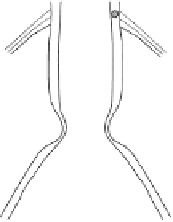Biomedical Engineering Reference
In-Depth Information
Fig. 3.1.
Ventral sections of syrinxes. (
a
)Tra-
cheobronchial syrinx with two sound sources,
particularly common in Oscines (brown
thrasher,
Toxostoma rufum
). The two vocal
valves are formed by adduction of the lateral
and medial labia on each side. LL, ML, lat-
eralandmediallabia;MTM,medialtympan-
iform membranes; T1, first tracheal ring; B3,
B4, third and fourth bronchial rings; P, ossi-
fied pessulus; SY, syringeal muscle. (redrawn
from [Larsen and Goller 2002]). (
b
)Tracheal
syrinx (ring dove,
Streptopelia risoria
). Con-
striction of the lumen by the lateral tym-
paniform membranes forms the only vocal
valve. LTM, lateral tympaniform membranes;
MTM, medial tympaniform membranes; T1,
T2, first and second tracheal rings; B1, first
bronchial ring; TL, tracheolateralis muscle;
ST, sternotrachealis muscle (redrawn from
[Gaunt et al. 1982]). (
c
) Bronchial syrinx (oil-
bird,
Steatornis caripensis
). Note that the dif-
ferent bronchial lengths, measured from the
valves to the trachea, make the syrinx asym-
metric. This characteristic has been proved to
stamp its signature on the song, which shows
two distinct formant bands. LTM, MTM, lat-
eral and medial tympaniform membranes; TL,
tracheolateralis muscle; ST, sternotrachealis
muscle; SY, syringeal muscle (redrawn from
[Suthers 2001])
(a)
trachea
SY
T1
ML
P
LL
B3
MTM
B4
bronchus
1 mm
(b)
ST
trachea
TL
T2
LTM
T1
B1
MTM
bronchus
(c)
trachea
ST
TL
SY
bronchus
LTM
MTM
5 mm
the sound with possibility of extremely rich spectral features. In Fig. 3.2, we
show a sonogram associated with the song of the eastern slaty thrush (
Turdus
subalaris
) [Straneck 1990b] in which the two sources are active. Notice that we
have a series of notes of approximately constant frequency between 8 kHz and
9 kHz (indicated as “source 1”), and simultaneously we have a second series
of notes of a slightly lower frequency (between 7 kHz and 8 kHz, indicated as
“source 2”) similar to the first, but with independent dynamics.
The richness that the syrinx imprints on the song does not end with the
possibility of choosing one of two sources, or singing with two sources at
the same time: it is at the level of the syrinx that the bird defines the es-
sential properties of its vocalizations. This is a point of difference between
birdsong and the utterance of voiced sounds by humans. The diversity of
























































































